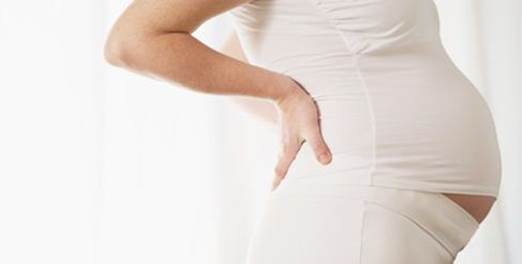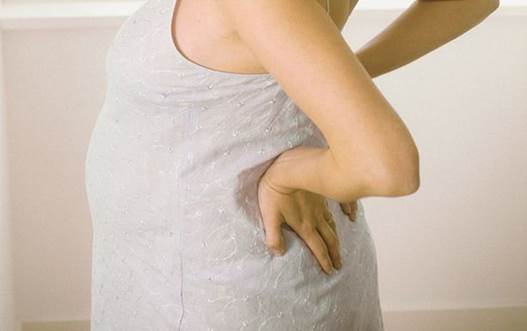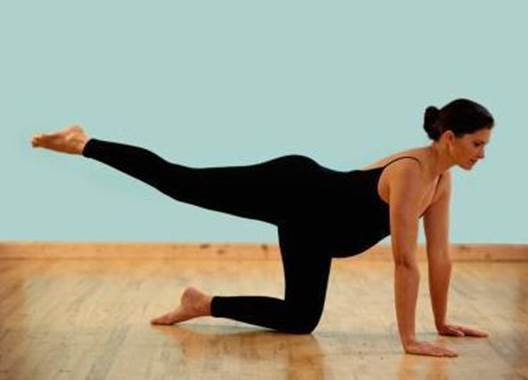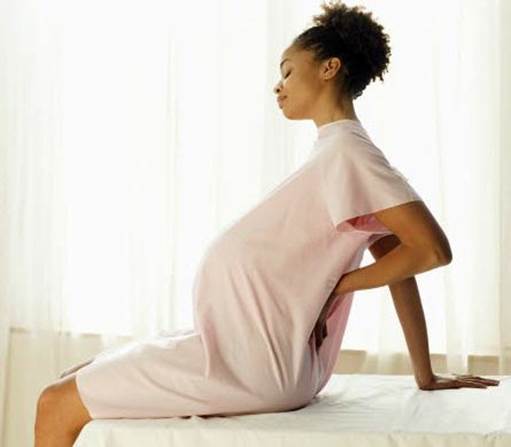Backache while you are pregnant is so
common – but with good back hygiene pregnancy doesn’t have to be a pain in the,
well...
Your baby at 5 months
Track your baby’s progress
Size: During
this month your baby may grow from about 142g or about the size of a mango to,
by the end of the month, match the size of a small doll – weighing about 450g
and measuring about 20cm from crown to rump (head to bum).
Progress:
This month kicks off a real growth spurt for your baby. Cells are dividing,
expanding and maturing in every part of his body.
Body: Your
baby’s mouth and nose are well developed. His hands and fingers are clearly
visible and the nail beds have been laid down. His fingers will close if the
palm of his hand is touched – he will even be able to suck his little thumb
purposefully.

This
month kicks off a real growth spurt for your baby.
Your spine is a cleverly designed support
system. Like the spine of a book it quite literally connects and holds the body
together. Every muscle is directly or indirectly dependent on the spine in some
way. When your back hurts, it affects many other parts of your body and can
cause you to become tired, grumpy and generally not nice to be around. Anxiety
and stress frequently manifest in our backs. Coping with life becomes
difficult, never mind dealing with the added stress of a pregnancy.
The spine is not one straight rod, but has
natural curves, which act as springs or shock absorbers as they absorb some of
the impact of the body weight on the ground.
The spine is divided up into separate parts
that each has its own characteristics and degree of mobility. First are the
seven small vertebrae supporting the head and the neck – the top two allow us
to rotate and nod our head.

Like
the spine of a book it quite literally connects and holds the body together.
Next are the 12 thoracic vertebrae to which
the ribs are attached. Not much movement here, as these protect the lungs and
the heart. The spine curves outwards here and can become prone to hunchback.
There is a constant need to pull up and stand tall as far as this part of the
back is concerned.
The five lumbar vertebrae carry the main
weight of the body and are very mobile. There is a lot of stress and strain in
this area which is susceptible to pain and injury, and is most prone to disc
problems. During pregnancy it can become exaggerated and strained.
The pregnant back
Now that you understand the spine you are
able to understand why backache during pregnancy is more likely to occur. There
is a natural tendency to sway back onto your heels as your center of gravity
moves. As your uterus and baby grow they put pressure on the main supporters of
the back, the abdominal muscles.
If these are weak and give way it will
allow an exaggerated curve in the lumbar area, which means the natural curve
will be more pronounced and there will be more pressure in this area. (Y our
pelvis is tipping forward and your buttocks are popping outward exaggerating
the slight figure S your spine usually has.) It can hurt across your shoulders,
because of the forward pull of your breasts and the poking forward of your
chin. Your rib cage is under pressure from your slouching shoulders and chest,
so breathing becomes more difficult. A weakened pelvic floor and short, tight
hamstring muscles will also play their part in adding to the strain your back
is taking.

As
your uterus and baby grow they put pressure on the main supporters of the back,
the abdominal muscles.
Mechanically, all this is happening, while
hormonally other things are going on. The hormones are responsible for causing
the strong ligaments that support these muscles to soften and loosen.
Relaxing is the main culprit here, as it
prepares the pelvis to relax and accommodate your growing baby as well as open
up a thoroughfare during labor and delivery. As well as adding to your backache
woes, it can make you feel a little unsteady on your feet and a bit clumsy as
you go about your normal daily activities.
Back to basics
The first step in caring for our backs is
basic maintenance. Maintaining a healthy back is easier than you think and the
rewards are great. This is not only essential during pregnancy, but should be
continued for life. The benefits are numerous to both body and mind.
Consider these few points when thinking
about back basics
·
Posture: Yes you
hate the word, but it is the first and foremost point that needs to be
addressed when dealing with back pain. Bad posture does not only give you a
pain in the neck (and back) but also affects breathing, joint pain, rib
discomfort, circulation and contributes to sore feet and fatigue. Bad posture
means that your body is not “stacked” the way it should be, and some muscles
are overstraining while others are too loose and relaxed. There is imbalance.
·
Exercise: Another
word you love to hate – second only to posture when treating and dealing with
backache. In this way muscles retain their tone and elasticity so that they
fully support the spine. Strong abdominal muscles will work in harmony to
further support your back. As a result the lightness in the chest relieves the
overworked lumbar spine and decreases breathlessness. The benefits of exercise
are well known, and it is a pity that we do not do more of it. We tend rather
to put things onto or into our bodies.

The
benefits of exercise are well known, and it is a pity that we do not do more of
it.
·
Environment: Try
checking your environment to see that working surfaces, car seats, wash basins
and cupboards are correctly placed and comfortable for you. Are your pillows
and bed comfortable, and do they support you properly?
·
Body awareness:
Be aware of anything, which may aggravate your back. For example, do you hold
the telephone in the crook of your neck? Do you drive with the window open or
the air-conditioner blowing on one side of your body? Do you slouch when you
sit? Do you stand for long periods of time and are your shoes the correct
height?

Do
you drive with the window open or the air-conditioner blowing on one side of
your body?
Top tips
1. Enroll in a prenatal exercise class that focuses on building the
strength and suppleness of the pregnant body.
2. Change your environment to ease the workload on your back.
3. Think posture, posture, and posture all the time.
4. Massage is a wonderful way to ease pain and tension in an aching
back.
5. Use heat to ease any spasm you may suffer from.
6. Visit an osteopath, chiropractor or physiotherapist for treatments
if the pain is intolerable.
7. Maintain excellent nutrition. This will boost your energy levels.
8. Lastly, don’t take your back for granted. It is the coat hanger that
your body clings to, so take good care of it. It cannot be replaced.